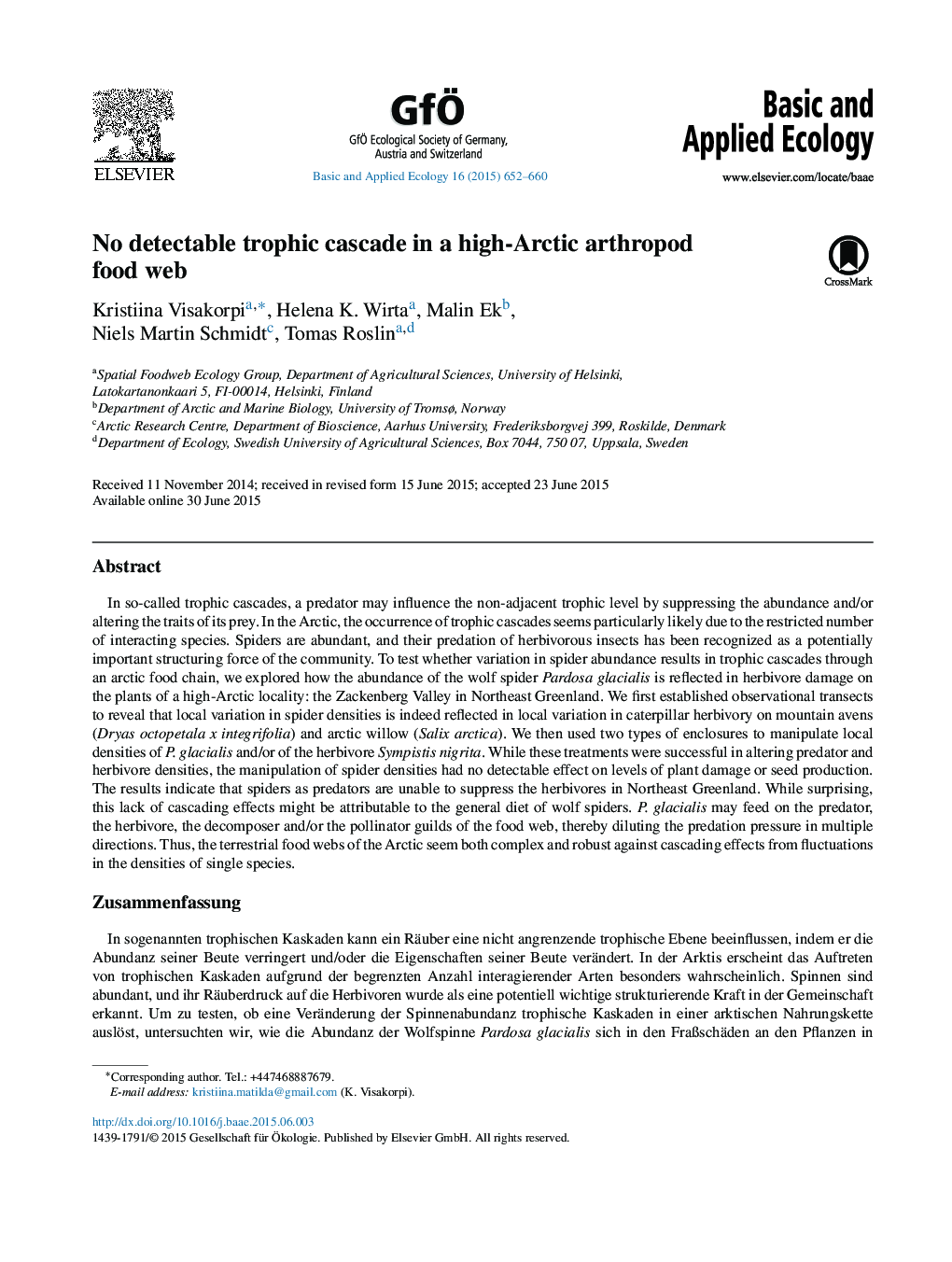| کد مقاله | کد نشریه | سال انتشار | مقاله انگلیسی | نسخه تمام متن |
|---|---|---|---|---|
| 4384038 | 1304384 | 2015 | 9 صفحه PDF | دانلود رایگان |
• Wolf spiders form the top predators among high-Arctic invertebrates.
• We explore whether predation by spiders may suppress herbivory or pollination.
• Across the tundra, higher spider densities were associated with lower herbivory.
• Experimental manipulations of spider densities did not affect plant performance.
• The lack of cascading effects might be due to an unexpectedly complex food web.
In so-called trophic cascades, a predator may influence the non-adjacent trophic level by suppressing the abundance and/or altering the traits of its prey. In the Arctic, the occurrence of trophic cascades seems particularly likely due to the restricted number of interacting species. Spiders are abundant, and their predation of herbivorous insects has been recognized as a potentially important structuring force of the community. To test whether variation in spider abundance results in trophic cascades through an arctic food chain, we explored how the abundance of the wolf spider Pardosa glacialis is reflected in herbivore damage on the plants of a high-Arctic locality: the Zackenberg Valley in Northeast Greenland. We first established observational transects to reveal that local variation in spider densities is indeed reflected in local variation in caterpillar herbivory on mountain avens (Dryas octopetala x integrifolia) and arctic willow (Salix arctica). We then used two types of enclosures to manipulate local densities of P. glacialis and/or of the herbivore Sympistis nigrita. While these treatments were successful in altering predator and herbivore densities, the manipulation of spider densities had no detectable effect on levels of plant damage or seed production. The results indicate that spiders as predators are unable to suppress the herbivores in Northeast Greenland. While surprising, this lack of cascading effects might be attributable to the general diet of wolf spiders. P. glacialis may feed on the predator, the herbivore, the decomposer and/or the pollinator guilds of the food web, thereby diluting the predation pressure in multiple directions. Thus, the terrestrial food webs of the Arctic seem both complex and robust against cascading effects from fluctuations in the densities of single species.
ZusammenfassungIn sogenannten trophischen Kaskaden kann ein Räuber eine nicht angrenzende trophische Ebene beeinflussen, indem er die Abundanz seiner Beute verringert und/oder die Eigenschaften seiner Beute verändert. In der Arktis erscheint das Auftreten von trophischen Kaskaden aufgrund der begrenzten Anzahl interagierender Arten besonders wahrscheinlich. Spinnen sind abundant, und ihr Räuberdruck auf die Herbivoren wurde als eine potentiell wichtige strukturierende Kraft in der Gemeinschaft erkannt. Um zu testen, ob eine Veränderung der Spinnenabundanz trophische Kaskaden in einer arktischen Nahrungskette auslöst, untersuchten wir, wie die Abundanz der Wolfspinne Pardosa glacialis sich in den Fraßschäden an den Pflanzen in einem Gebiet der Hocharktis, dem Zackenbergtal in Nordost-Grönland abbildet. Wir richteten zuerst Beobachtungstransekte ein, um festzustellen, dass sich die lokale Variation der Spinnendichten tatsächlich in der lokalen Variation des Raupenfraßes an der Silberwurz (Dryas octopetala x integrifolia) und der Arktischen Weide (Salix arctica) widerspiegelt. Wir richteten dann zwei Typen von Käfigen ein, um die Abundanzen von P. glacialis und/oder des Herbivoren Sympistis nigrita (Noctuidae) zu manipulieren. Während diese Behandlungen die Räuber- und Herbivorendichten erfolgreich veränderten, hatte die Manipulation der Spinnendichten keinen erkennbaren Effekt auf den Grad des Fraßschadens oder die Samenproduktion. Die Ergebnisse zeigen an, dass Spinnen als Prädatoren nicht in der Lage sind, die Herbivoren in Nordost-Grönland zu kontrollieren. Dieses Fehlen eines Kaskadeneffekts könnte auf das generalistische Nahrungsspektrum der Wolfspinnen zurückzuführen sein. P. glacialis könnte Beutetiere aus den Räuber-, Herbivoren-, Zersetzer- und/oder Bestäuber-Gilden des Nahrungsnetzes fangen, wodurch der Räuberdruck in mehrere Richtungen gemindert wird. Damit scheinen die terrestrischen Nahrungsnetze der Arktis sowohl komplex als auch robust gegen Kaskadeneffekte, die sich aus Populationsschwankungen einzelner Arten ergeben könnten, zu sein.
Journal: Basic and Applied Ecology - Volume 16, Issue 7, November 2015, Pages 652–660
